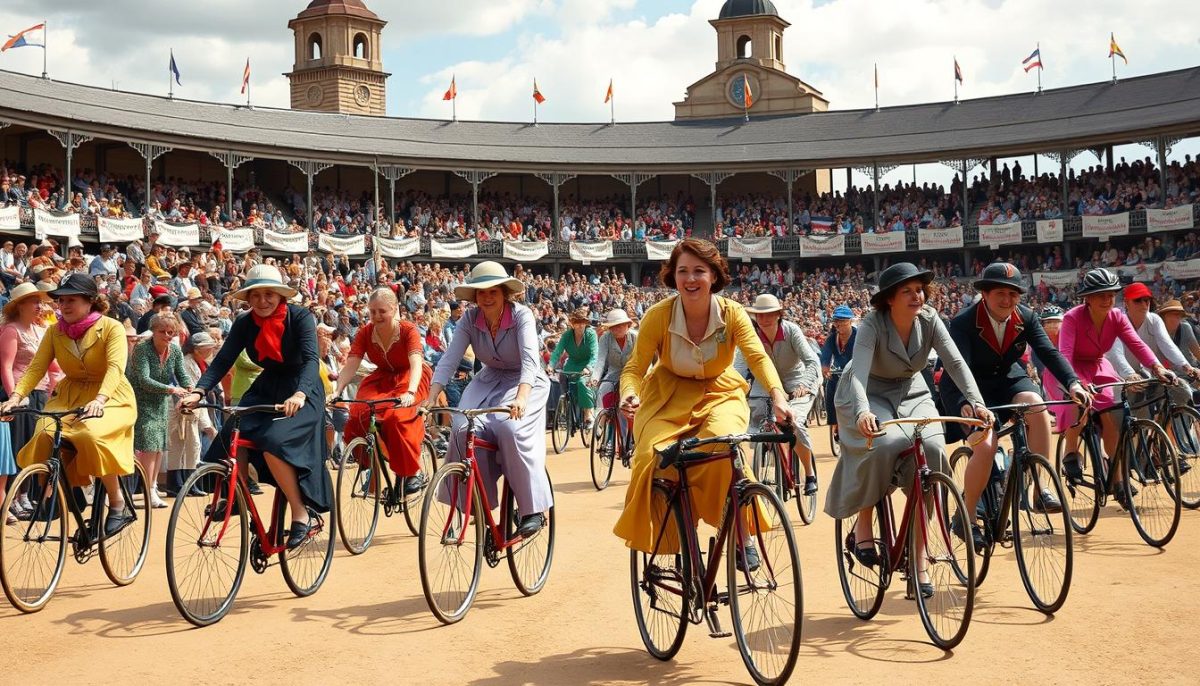Mlle Serpolette at the Velodrome d’Hiver 1896
Mlle Serpolette stands out as a remarkable figure in women’s cycling history, having achieved a significant milestone during the 1896 cycling event at the historic Velodrome d’Hiver in Paris. This iconic venue not only hosted thrilling races but also symbolized a cultural shift towards the inclusion of women in sports. Serpolette’s cycling triumph marked a pivotal moment, showcasing her skill and determination while paving the way for future generations of women athletes.
The Historic Context of Cycling in 1896
The year 1896 marked a significant turning point in the history of cycling, particularly regarding women’s cycling growth. This period witnessed a transformation as social attitudes towards women in sports began to evolve. The popularization of cycling created new opportunities for women to engage in competitive activities, breaking traditional barriers and establishing their place in a predominantly male domain.
The Rise of Women’s Cycling
During the late 19th century, the rise of women’s cycling became emblematic of a broader movement towards gender equality in sports. Women began to embrace cycling as a means of self-expression and physical activity. The growing acceptance of women participating in competitive cycling events catalyzed a cultural shift that challenged long-held societal norms. Pioneering figures like Annie Londonderry and Matilda Harvey became household names, garnering public attention and inspiring others with their remarkable achievements.
Key Figures in Early Cycling History
The history of cycling is rich with pioneering individuals who played crucial roles in shaping the landscape of women’s participation. Their contributions laid the groundwork for future generations, facilitating the advancements that would take place in cycling. Below is a table showcasing some of these influential cycling pioneers:
| Name | Contribution | Impact on Cycling |
|---|---|---|
| Annie Londonderry | First woman to bicycle around the world | Increased visibility of women’s cycling |
| Matilda Harvey | Competitor in long-distance cycling events | Challenged gender stereotypes in sports |
| Selina M. G. Keats | Advocate for women’s cycling rights | Promoted inclusion in competitive cycling |
During the 1896 cycling context, these women’s efforts symbolized a broader movement towards equality. Their determination and spirit inspired many and set the stage for future advancements in women’s cycling, leading to significant milestones in years to come.

Mlle Serpolette at the Velodrome d’Hiver 1896
Mlle Serpolette emerged as a remarkable figure in the realm of early women cyclists. Her journey serves as a pivotal chapter in French cycling history, particularly during a time when the sport was predominantly male-dominated. Understanding her background provides insight into her tenacity and determination as a sports pioneer.
A Look at Mlle Serpolette’s Background
The Mlle Serpolette biography reveals a young woman driven by passion and ambition. Born into a society where women faced numerous obstacles, she challenged the status quo by engaging in competitive cycling. With the support of like-minded individuals, she honed her skills, preparing for her debut at the Velodrome d’Hiver in 1896.
Mlle Serpolette’s training involved rigorous routines that showcased her commitment to the sport. Her participation symbolized not only her personal achievements but also the strides made by early women cyclists in France. Each pedal stroke on the track pushed against the barriers of gender norms, highlighting her role as a precursor to future generations of female athletes.
The significance of her journey resonates beyond racing; it reflects the collective resolve of sports pioneers breaking ground in various fields. By excelling in a challenging environment, Mlle Serpolette contributed to a narrative that would inspire many, paving the way for the evolution of women’s cycling and broader acceptance in sports.
The Spectacle of the Velodrome d’Hiver
The Velodrome d’Hiver stands as an iconic venue within the cycling events history, celebrated for its striking design and remarkable features. Its architecture not only provided an impressive backdrop but also contributed significantly to the atmosphere that defined racing events in the late 19th century. This section explores the unique characteristics of Velodrome d’Hiver architecture, emphasizing its role in promoting cycling as an esteemed sport.
Architecture and Significance of the Venue
The Velodrome was designed to accommodate large crowds while creating an intimate setting for the athletes. Its innovative structure, featuring a wood-paneled interior and a massive glass roof, allowed natural light to flood the space, enhancing visibility during events. This design contributed to the engaging environment that spectators enjoyed, fostering a sense of community and enthusiasm for cycling.
Additionally, the significance of Velodrome d’Hiver cannot be overstated. It served as a platform for showcasing not just cycling but also a more progressive view of women’s roles in sports. Events held here began to shift public perception, allowing women like Mlle Serpolette to emerge as celebrated figures in cycling.
Major Events Leading Up to 1896
As the years progressed towards 1896, the Velodrome d’Hiver hosted numerous pivotal events that would shape the cycling landscape. These events brought together diverse talent and drew significant crowds. Key competitions included the French National Championships and various international races, each drawing attention to both male and female cyclists, thus heightening interest in the sport.
Amidst the vibrancy of these competitions, the Velodrome became synonymous with exciting athleticism and community spirit, setting the stage for monumental moments in cycling history.

The Legacy of Mlle Serpolette’s Triumph
Mlle Serpolette’s remarkable performance at the Velodrome d’Hiver in 1896 holds a significant place in the history of women’s sports. Her triumph not only showcased the potential of female athletes but also served as a catalyst for future generations of women in competitive cycling. The Mlle Serpolette legacy extends beyond her era, influencing the gradual acceptance and recognition of women in various athletic fields, particularly cycling.
The impact on women’s sports has been profound, with Mlle Serpolette’s achievements paving the way for the increased visibility and participation of female cyclists. As societal attitudes shifted, more women began to engage in competitive cycling, building upon the groundwork she established. Her victories are often referenced by contemporary female cyclists who see her as a trailblazer in their quest for equality and representation in the sport.
Today, as we reflect on cycling history influence, it is clear that Mlle Serpolette’s contributions were pivotal in advancing women’s achievements in cycling. Her legacy not only inspires current athletes but also challenges the ongoing barriers that still exist in various sports. The relationship between her success and the modern evolution of women’s participation in athletics reminds us that every milestone is built upon the achievements of those who came before.

